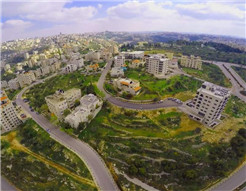Ramallah, Palestine
Smart City, Freedom Through Technology

Background Information
This is an independent initiative by the Ramallah Municipality. However, the initiative has been endorsed and supported by the Ministry of Telecommunication & Information Technology (MTIT) and the Ministry of Local Government (MOLG). MTIT is a member of the steering committee for the project and the MOLG is supportive of the project and has adopted some of its output (namely the GIS component), and is working on disseminating it to other local councils in the West Bank and Gaza Strip under a national GIS initiative. The governmental support offers sustainability and potential for the application to other municipalities in Palestine since Ramallah has become a model in this field.
Goals of the Initiative
The project aims to enhance relations and communications with the local community, provide quality 24/7 services without the need in many types of services for the personal presence of the citizens, provide information to the public on the activities and public events organized by the municipality and to get feedback from citizens on the services provided by the municipality. The project also provides tools and applications that allow for updating data directly from the field and enhancing the quality and inclusiveness of the databases of the municipality concerning buildings, infrastructure and residents. The project, thus, provides reliable information for the purposes of planning and decision making, mainly through the GIS component of the project. Since Google Earth is restricted in the West Bank, the project provides an alternative for navigation. The project also included installing cameras at major intersections and providing live streaming. The cameras were very useful during emergencies and snow. It helped individuals and investors develop applications for visitors, like e-payments for parking spots
Parties and Partners to the Initiative
The project is a great example of public-private partnership and collaboration between the central and local governments. Although it was originated upon an initiative by the municipality, its implementation was done through partnership and cooperation with the private sector, especially the telecommunications sector, in addition to experts from academia and PITA (Palestinian Information Technology Association of Companies). The central government was also involved in the project through membership of the MTIT in the steering committee of the project, and the MOLG adopted the GIS component as a national model working on disseminating it to other municipalities. Additionally, international donors, like GIZ and USAID, were involved in providing financial support.
Resources Used for Implementation
The implementation relied mainly on local human resources in partnership with the private sector and with the support of the central government and international donors. However, the idea was developed solely by the Ramallah Municipality’s staff.
Innovation for the Initiative
The idea of the project is considered a revolutionary idea within the Palestinian context. The MTIT supported the project and is working on disseminating it to other municipalities in the West Bank.
Innovation has been applied in
The project is part of a strategic plan of the municipality for the coming five years. A substantial part of it has already been implemented and the municipality has a clear plan for the implementation of the remaining parts of the project
Obstacles and Solutions for Innovation
The implementation of the project has faced (and still faces) tremendous challenges. A major challenge is the outdated legal framework applicable in the West Bank which has major gaps, like the lack of e-signature law, cyber-crimes law and e-payment law. The Israeli authorities delay and sometimes prevent the import of certain technological equipment. The Israeli Occupation in general prevents the maximum utilization of technologies (3G/ LTE advanced, Fiber between cities, Google Maps)
Outcomes and Assessments
The project has achieved a major measurable impact, more than what was initially anticipated. This can be demonstrated through the number of hits on the municipality website and the increasing number of citizens using the municipality e-services. Additionally, there has been an upsurge in private sector investment in the technology sector in Ramallah, as demonstrated in the number of applications developed by private sector companies and individual investors relying on some aspects of the project. There has also been a significant increase in the number of citizens participating and attending public events organized by the municipality (mainly because of the advertising capacities of the project) and an increase in the number of advertisements using digital screens that have been erected in certain parts of the city as part of the project. Because of the infrastructure provided by the project, the municipal council decided to broadcast at least one session of its weekly meetings allowing citizens and stakeholders to watch the entire session, and thus increase transparency of the work of the council.
Methods Applied
Internal policies and procedures have been significantly reengineered to be compatible with the new databases and technological tools. For example, each department of the municipality has an application on the GIS which has become part of work flow and documentation procedures. The municipality now does not accept applications that are not electronic, in order to facilitate processing of application, tracking and timely responses. Other GIS applications are used to report incidents and complaints and track them.


 In Focus | World Cities Day: People-Centred Smart Cities
In Focus | World Cities Day: People-Centred Smart Cities City Stories | Fostering community resilience: A lifeline for the Central African Republic
City Stories | Fostering community resilience: A lifeline for the Central African Republic In Focus | Innovative Education, Empowering Futures
In Focus | Innovative Education, Empowering Futures




















 Tel: +86 020 3780 4434
Tel: +86 020 3780 4434 Email: info@guangzhouaward.org
Email: info@guangzhouaward.org Adress: Unit 01-7, 28th Floor, No. 7, Chunrong 3rd Road, Tianhe District, Guangzhou, Guangdong, 510000, PRC
Adress: Unit 01-7, 28th Floor, No. 7, Chunrong 3rd Road, Tianhe District, Guangzhou, Guangdong, 510000, PRC




